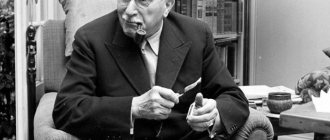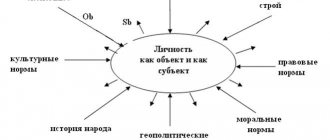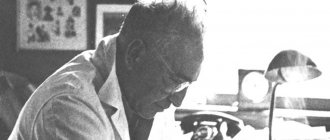General understanding of the cognitive theory of personality
The founder of the cognitive approach to personality development is the American psychologist John Kelly.
According to his theory, the main source of human personality development is his environment and social environment. The peculiarity of the nominal cognitive approach is that special attention is paid to the influence of intellectual processes on the characteristics of human behavior. In this theory, a person is presented in the role of a scientist who tests his hypotheses regarding the nature of things and, in accordance with this, makes a forecast for the development of events in the future.
Any event that happens to a person can be interpreted repeatedly and conclusions can accordingly change depending on the situation in which the person is at that particular moment.
Are you an expert in this subject area? We invite you to become the author of the Directory Working Conditions
Note 1
The main concept of the cognitive theory of personality is the concept of a construct, which includes the existing features of all known cognitive processes. It is thanks to the formed constructs that a person acquires the opportunity not only to understand the world, but also to build interpersonal relationships with other people. The construct is a kind of classifier - a template for a person’s perception of other people and himself.
Formation and directions of development
Cognitive psychology (Latin cognitio - knowledge, cognition) - the last of the modern trends - received official status in 1960, when George Miller and Jerome Bruner opened the first research center for cognitive psychology at Harvard. In 1967, American psychologist Ulrich Neisser outlined the cornerstones of the field in his book Cognitive Psychology and identified cognitive processes, both conscious and unconscious, as the object of his scientific interest. Together with Gestalt psychology and the humanistic movement, cognitivists opposed the exclusion of the role of the psyche in the regulation of behavior in behaviorism and psychoanalysis.
The scientific prerequisites for the emergence of cognitive psychology were the ideas about the priority of cognitive processes and the internal plan in the regulation of animal behavior (E. Tolman and W. Koehler) and the leading role of intelligence in the adaptation and mental development of a child (J. Piaget). Another important ideological source for the development of cognitive psychology was the postulates of cybernetics as the science of signal regulation and control of systems (technical, organic, psychological and social), set out in 1948 by the famous American mathematician Norbert Wiener in his book “Cybernetics, or control and communication in living organisms.” and cars." At the social level, the leading role of thinking in human life has been experimentally demonstrated in studies of the influence of social facts on memory (Frederick Bartlett) and perception (Jerome Bruner). Based on the above concepts, the main idea of cognitive psychology was the affirmation of the leading role of cognitive processes in human life.
+Currently, there is no unified theory or approach in the field of cognitive psychology. The initial methodological basis of many cognitive concepts is the nomothetic (or informational) approach, which affirms the so-called “computer metaphor” in human understanding. This is pure laboratory psychology, the main assumptions of which are the concepts of stage-by-stage information processing, the limited capabilities of the information processing system and the postulate of information coding. An example of the implementation of the information approach is Richard Atkinson's concept of a three-component memory model, in which human cognitive processes are considered as an analogue of information transformation in a computing device.
Robert Sternberg, in accordance with the nomothetic approach, proposed a componential model of intelligence that includes five classes of mental processes that are sequentially involved in problem solving. At the same time, intelligence is understood by the author not as a static entity measured by traditional intelligence tests, but as a much broader concept that relates to the possibility of practical application of intelligence. The ability to apply personal potential in practical life is reflected today in the concept of “competence”. Like Stenberg, Gardner Howard, the author of the theory of multiple intelligences, believed that traditional intelligence tests were unable to measure and examine all aspects of intelligence. Such tests can predict school performance, but they cannot predict future life and career growth. According to G. Gardner, intelligence is a multiple construct consisting of seven types of intelligence (verbal, spatial, personal, interpersonal, bodily-kinesthetic, logical-mathematical, musical). The founder of cognitive psychology, Ulrik Neisser, also initially worked in line with the information approach. He studied cognitive processes in the laboratory by simulating the flow of information at various stages of its transformation, and introduced terms such as “iconic memory” and “echolocation memory.”
Basic provisions of the cognitive theory of personality according to J. Kelly
It was Kelly who, in his research, described the basic mechanisms of the functioning of personal constructs. He also formulated the main postulate of this theory and the consequences that arise according to this postulate
The postulate states that personal processes are psychologically canalized in such a way as to provide a person with maximum prediction of events. All other emerging consequences only clarify this basic postulate.
Finished works on a similar topic
Course work Personality in cognitive psychology 440 ₽ Essay Personality in cognitive psychology 280 ₽ Test paper Personality in cognitive psychology 210 ₽
Receive completed work or specialist advice on your educational project Find out the cost
A person can differ from another not only in the number of formed constructs, but also in their location. There are superordinate constructs that are actualized in a person’s consciousness in a short period of time, and subordinate constructs that are slower.
Note 2
The system of constructs in a person’s personality is not static and is in the process of constant change due to the influence of the experiences a person receives in the process of growth and development. Thus, we can say that a person’s personality is formed and develops throughout life.
The scientist assumed that the human personality has limited free will and life activity. The system of constructs that has been formed in one or another individual contains certain limitations. However, Kelly did not believe that all human life is completely determined. In any situation, a person is able to construct alternative predictions.
Thus, we can say that the external world of a person is not good or evil, it is exactly the way a person constructs it in his mind.
Ultimately, according to cognitive scientists, a person's fate is in his hands.
Ecological approach
Later, U. Neisser moved to the position of an ecological approach - to the study and formation of human skills in real life conditions (in production, in the process of solving real problems, etc.). V. Neisser’s departure from nomothetic methodology was due to the understanding of the fact that when studying artificial perceptual models it is impossible to take into account all the information stimuli that a person receives in natural, information-rich conditions. The problem of low “ecological validity” of data obtained in laboratory experiments, expressed in their low suitability for describing behavior outside the framework of an artificially created experimental situation, has become acute. These ideas of V. Neisser were reflected in his new book “Cognition and Reality” (1976).
An important area of research in cognitive psychology is the study of the role of the unconscious in the processing of cognitive information. Experiments by Donald Broadbent and Anna Trisman with simultaneous delivery of different signals to the left and right ears through headphones showed that the unconscious part of information processing is involved in the initial stages of perceiving new material. Analysis of information at the unconscious level occurs continuously, and from the countless amounts of information received per unit of time, the cognitive system at all levels selects and brings to consciousness only those signals that are most important at the moment.
In addition to the study of cognitive activity, cognitive psychology has also created theories of a social psychological nature. This tendency is most clearly represented in Leon Festinger's theory of cognitive dissonance. Developing the ideas of Kurt Lewin, L. Festinger came to the conclusion that people seek an internal balance between the information they receive and their existing motives for behavior. Dissonance between information and behavior is experienced as an unpleasant state of disequilibrium that must be corrected by changing behavior or attitudes.
In the context of cognitive theories of personality, it is worth highlighting George Kelly’s theory of personal constructs, formulated in the 1950s, according to which a person’s holistic behavior is determined by an individual system of polar constructs, on the basis of which hypotheses about future events are built. A person chooses the pole that has greater predictive value and acts in accordance with this hypothesis. If the hypothesis is not confirmed, the construct system is rebuilt to increase the adequacy of subsequent predictions. Thus, J. Kelly affirms the leading role of intellectual processes in human life. Therefore, despite the fact that J. Kelly's theory anticipated the advent of cognitive psychology, the theory of personality constructs was associated with cognitive theories of personality.
In psychotherapeutic practice, the cognitive approach is represented in rational-emotive psychotherapy developed by Albert Ellis (RET, 1962) and Aaron Beck's cognitive therapy (1970s). Cognitive approaches to psychotherapy are those that emphasize a logical, intellectual approach to solving psychological problems. Ellis's RET was based on the assumption that negative emotions and dysfunctional behavioral responses are not the result of the experience itself, but the interpretation of it. Ellis proposed the “A-B-C” model, where A is the activating event, B is the judgment, and C is the dysfunctional emotion, i.e. consequence. Analysis of difficult life situations according to this scheme makes it possible to clarify to the client’s personality the fact that the consequences depend not on the situation (A), but on the rationality/irrationality of the judgment about it (B), and on this basis to adjust the judgment. Beck's therapy combines psychoanalysis (automatic thoughts learned in childhood) and behaviorism (neurosis and therapy viewed from a learning perspective).
Personality structure according to the cognitive theory of personality
As mentioned above, the construct is the main conceptual element of personality. Each person has his own individual system of personal constructs, which is divided into two interconnected blocks:
- The block of “nuclear” constructs, which includes about 50 basic constructs located at the top of the system and in the main focus of a person’s operational consciousness. A person uses the constructs included in this block most often in the process of interacting with people around him.
- The second block is the block of peripheral constructs, which includes all other constructs. Their number is strictly individual and can reach several thousand.
Holistic personality traits appear as a result of the joint functioning of both blocks, all constructs.
Introduction to Cognitive Psychology
Research in the field of psychology and ethics of business communication conducted in Western countries is based on certain provisions of the existing areas of general and social psychology when solving theoretical and methodological problems. For this purpose, the fundamental principles of such directions as behaviorism, cognitive psychology, Gestalt psychology, field theory, psychoanalysis, humanistic psychology, and interactionism are used. That general revolution in views and fundamental views on the essence, subject and methods of psychological science, which has now taken especially sharp and vivid forms in Russia, cannot, of course, pass without leaving a trace and unnoticed for the entire applied field of psychology. If in the field of theoretical knowledge there is a radical breakdown of old concepts and ideas, a fundamental restructuring of ideas and methods, then in applied disciplines, representing branches from the common trunk, so those painful and fruitful processes of destruction and restructuring of the entire scientific system are inevitable. The restructuring of psychological ideas that is taking place now directly causes a radical change in scientific views on the very essence of the pedagogical process. We can say that here for the first time education is revealed in its true essence for science, that for the first time here the teacher finds the ground to talk not about guesses and metaphors, but about the exact meaning and scientific laws of educational work.
Peculiarities
Incompetent people often equate behaviorism and cognitive orientation. However, as mentioned above, these are separate, independent disciplines. The first is focused only on observing human behavior and the external factors (stimulus, manipulation) that shape it. Today, some of its scientific provisions are recognized as erroneous. Cognitive psychology can be briefly and clearly defined as a science that studies the mental (internal) states of a person. It is distinguished from psychoanalysis by scientific methods (rather than subjective sensations) on which all research is based.
The range of topics covered by the cognitive direction includes perception, language, memory, attention, intelligence and problem solving. Therefore, this discipline often overlaps with linguistics, behavioral neuroscience, issues of artificial intelligence, etc.
Story
Cognitive psychology began with a meeting of young electronic engineering specialists at the University of Massachusetts on November 11, 1956. Among them were today's famous psychologists Newell Allen, George Miller and Noam Chomsky. They were the first to raise the question of the influence of human subjective cognitive processes on objective reality.
The book “The Study of Cognitive Development” by J. Bruner, published in 1966, became important for the understanding and development of the discipline. 11 co-authors, specialists from the Harvard Research Center, worked on its creation. However, the main theoretical work of cognitive psychology is recognized as the book of the same name by Ulric Neisser, an American psychologist and teacher at Cornell University.
Connection to neuroscience
Neuroscience is the study of behavioral processes in a broader sense. Today this science is developing in parallel and actively interacts with cognitive psychology. Briefly it touches on the mental level, and places greater emphasis on physiological processes in the human nervous system. Some scientists even predict that in the future the cognitive field may be reduced to neurobiology. The only obstacle to this will be theoretical differences between disciplines. Cognitive processes in psychology, in short, are more abstract and irrelevant to the views of neuroscientists.
Methods
The main method of cognitivists is to replace the personal construct. Its development belongs to the American scientist J. Kelly and dates back to 1955, when the new direction had not yet been formed. However, the author’s work has largely become decisive for cognitive psychology.
Briefly, the personality construct is a comparative analysis of how different people perceive and interpret external information. It includes three stages. At first, the patient is given certain tools (for example, a thought diary). They help identify erroneous judgments and understand the causes of these distortions. Most often, they are states of passion. The second stage is called empirical. Here the patient, together with the psychotherapist, practices techniques for the correct correlation of phenomena of objective reality. This is done by formulating adequate arguments for and against, a system of advantages and disadvantages of behavioral models, and conducting experiments. The final step is for the patient to become more aware of his or her response. This is a pragmatic stage.
In short, Kelly’s cognitive psychology (or personality theory) is a description of the very conceptual scheme that allows a person to comprehend reality and form certain patterns of behavior. It was successfully picked up and developed by Albert Bandura. The scientist identified the principles of “observational learning” in behavior modification. Today, the personality construct is actively used by specialists around the world to study depressive states, phobias of patients and identify/correct the causes of their low self-esteem. In general, the choice of cognitive method depends on the type of mental behavioral disorder. These could be methods of decentering (for social phobia), replacing emotions, changing roles, or targeted repetition.









